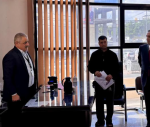AMMAN — Voicing its support for utilising wind energy in Jordan, the Royal Society for the Conservation of Nature (RSCN) on Thursday said the government and renewable energy companies must follow safety guidelines when establishing wind farms.
There are numerous plans for establishing wind energy projects in the Kingdom; therefore, it is imperative for the government and investors alike to consider environment and wildlife protection during the planning, implementation and operation of wind farms, RSCN Chairman Khaled Irani said.
“The society has always called for exploring clean, renewable energy such as wind and solar power among other alternatives; however, renewable energy investments must take the protection of wildlife into consideration,” Irani said at a meeting to announce the society’s official stance on wind energy projects.
Energy experts and environmental activists say the government must explore alternative energy sources as Jordan has one of the highest annual daily averages of solar irradiance in the world, with 330 days of sunshine per year.
The Kingdom also has significant amounts of untapped wind energy, with wind speeds as high as 7.5 metres per second and up to 11.5 metres per second in hilly areas, according to experts.
Despite these advantages, renewable energy currently makes up less than 1 per cent of Jordan’s energy mix.
Irani, a former energy and environment minister, said the government plans to raise investments in green energy to ultimately produce 10 per cent of its energy needs by 2020 from renewable energy sources.
“It is vital to establish energy projects with a limited negative impact on biodiversity, especially birds and their natural habitat, by selecting wind farm sites after thorough studies and using the best-available technologies and turbine designs,” he noted.
Wind farms could have a significant impact on bird populations due to the risk of collision with turbines and towers, which could also be barriers to migratory birds, according to the RSCN, therefore, an environmental impact assessment (EIA) and intensive evaluation of the proposed site must be carried out before constructing a wind farm.
RSCN Director Yehya Khaled said at the meeting that the construction of wind energy projects should not be allowed inside nature reserves or public parks.
“In addition, establishing wind energy projects inside special conservation areas must not violate the regulations issued by the Ministry of Environment and an EIA must be conducted,” Khaled added.
He told The Jordan Times that some 50 wind farm projects are proposed to be established near the Dana Biosphere Reserve, which falls on the Rift Valley-Red Sea flyway.
More than 1.5 million birds belonging to 37 species, five of which are globally threatened, annually use this route, which is the second most important flyway in the world, according to Abdel Razzaq Hmoud, the coordinator of the RSCN’s Migratory Soaring Birds Project.
Hmoud underscored the society’s willingness to provide investors with all the information they need to implement wind energy projects while protecting wildlife.
As a signatory to the Convention on the Conservation of Migratory Species of Wild Animals in 2002 and the African-Eurasian Waterbird Agreement in 1999, Jordan is obligated to protect different species, including the migratory soaring birds that pass through the country in spring and autumn every year.
















